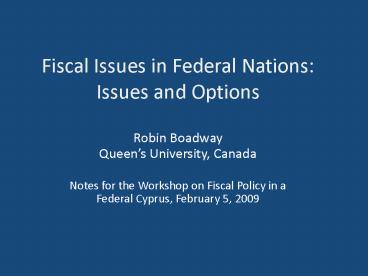Fiscal Issues in Federal Nations: Issues and Options PowerPoint PPT Presentation
1 / 18
Title: Fiscal Issues in Federal Nations: Issues and Options
1
Fiscal Issues in Federal NationsIssues and
Options
- Robin Boadway
- Queens University, Canada
- Notes for the Workshop on Fiscal Policy in a
Federal Cyprus, February 5, 2009
2
Overview
- Review of the key features of federal fiscal
structures - Division of responsibilities and federal
influence over states - Some issues in federal-state fiscal relations
- Responses to permanent, cyclical and asymmetric
shocks - How much decentralization is desirable?
3
Federal Fiscal Architecture
- Assignment and exercise of fiscal
responsibilities a compromise - To achieve the advantages of decentralization
- To maintain national efficiency and social policy
objectives - Additional fiscal objectives
- Respond to permanent shocks/asymmetries
- Respond to cyclical shocks
- Respond to asymmetric shocks
4
Some Features of Federations
- Decentralization of discretionary fiscal
borrowing powers and to states - Some state fiscal responsibilities have national
consequences - Free internal mobility of labour and capital
- Social protection a shared responsibility
- Vertical fiscal gap
- System of equalizing transfers
5
Federations vs. Economic Unions
- Relatively strong central government with taxing
and spending powers - Equalizing transfers
- Common currency but typically absence of explicit
Growth and Stability Pacts (though often
self-imposed balanced-budget constraints) - Harmonized tax systems
- Some harmonization of social protection
- Some federal influence over state decisions
6
Division of Fiscal Responsibilities
- State expenditures comparable to federal
- Local public goods and services
- Some major social protection programs
- Infrastructure
- Some power may be shared, with one level
paramount - Revenue decentralization varies greatly,
depending on access to broad-based taxes
7
Federal Influence over States
- Federal-state transfers (spending power)
- Close the fiscal gap
- Equalize and insure states against shocks
- Influence state spending priorities programs
- Other sources of federal influence
- Disallowance judicial review
- Mandates
- Moral suasion
8
Power to Borrow
- Federal government unconstrained
- State borrowing practices varies
- May have full discretion subject to capital
market - May be constitutional or legislative constraints
on state borrowing, or requirement for referendum - Typically no analog of SGP constraints with
penalties - Municipalities borrow for capital spending only
- Federal transfers can influence state borrowing
(positively or negatively)
9
Other Constitutional Provisions
- May be broad policy objectives, constraints or
directives - Internal economic union provisions
- Equalization provisions
- Social economic rights
- Regulation of capital, labour and product markets
may be shared - Federal responsibility for treaties may have
implications for states
10
Issues in Federal-State Relations
- Social protection
- State delivery of key programs, but federal
interest - Role of spending power, with limits
- Tax harmonization
- Use of shared tax bases
- Difficulties of sharing VAT
- Internal economic union
- Judicial vs. negotiated vs. spending power
remedies - Role of federal oversight more generally
- Equalization a key issue ???
11
Responses to Permanent Asymmetries
- Automatic redistribution through federal fiscal
policies depending on revenue centralization - Fiscal transfers to compensate for differences in
fiscal capacity and need - Decentralization makes it more difficult
- Depends on extent of national solidarity
- Migration of labour conflict with transfers
- Investment flows to capital-scarce states
- Potential for wasteful state competition
favouring better-off states (e.g. natural
resources)
12
Responses to Cyclical Shocks
- Standard prescription temporary deficits and
surpluses with structural balance - Many problems even in a unitary nation
- Debt not a full measure of government liabilities
- Permanent spending tax changes hard to undo
- Lags in discretionary fiscal policy
- More complicated in a federal setting
- Little federal control over state borrowing
13
Responses to Cycles, contd
- State policy may pro-cyclical depending on
- Automatic stabilizers
- Ability to borrow, revenue raising powers
- Federal influence limited by decentralization
- Federal inability to commit to transfers
- May pass on deficit to states in recession
- Soft budget also possible but less likely
- Equalization can be destabilizing if based on
average state fiscal capacity
14
Responses to Asymmetric Shocks
- Automatic regional insurance through federal
budget, depending on decentralization - With respect to decentralized revenues,
equalization automatically stabilizing,
especially if formula-based - Dangers of soft budget constraint if grants
discretionary - Balance-budget constraints counterproductive
15
How Much Decentralization?
- Main issue facing federations How much
decentralization of revenue raising? - Decentralization of revenue raising must involve
some broad-based tax - VAT difficult to decentralize administratively
- Income tax decentralized in harmonized way
- Payroll taxes good candidates (dual income tax)
- Decentralization makes discretionary fiscal
policy more difficult
16
Decentralization, contd
- Decentralization induces fiscal capacity
differences - Might reduce national solidarity
- Makes equalization more difficult
- Makes response to asymmetric shocks harder
- Decentralization might enhance accountability
- Reduces dependency
- Encourages responsible (hardened) budgets
- Prerequisite for credit market discipline
17
Decentralization, contd
- Decentralization might increase fiscal
competition - Good or bad?
- Might favour richer states
- Decentralization reduces influence of federal
government - Reduced chances of tax harmonization
- Reduces policy harmonization for social
protection - Checks intrusive federal use of spending power
18
Political Economy Issues
- Apparently, decentralization is much easier than
recentralization - Some evidence that decentralization improves
governance and reduces corruption - Debt performance seems to be better in
decentralized countries, especially the states - But, little evidence that imposed federal
controls and constraints on states work capital
markets and bond rating agencies more effective - Federal-state arms-length commissions and loan
councils might be useful as accountability
institutions

